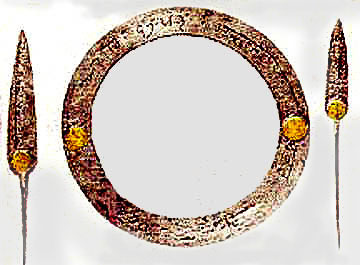Prof. Surinder Singh
Guru Arjan Dev Ji, the fifth Sikh Guru is said to have created a new instrument called the Saranda. Guru Gobind Singh Ji, the tenth Sikh Guru and the great-grandson of the fifth Guru, kept the family trend alive by creating the instrument named 'taus'. Taus is the Persian word for Peacock. The Taus is a blend of sarangi and sitar, well-known classical Indian instruments. Some scholars believe that the sitar was invented in Guru Gobind Singh's time period as well, and that the creation of new instruments was in fashion at that time. 
Painting of Bebe Nanki presenting the Rabab to Guru Nanak & Mardana
Painting of Guru Arjan Dev Ji performung kirtan with Saranda
The taus is painted in all of the bright shades of the beautiful bird, the peacock, in its sound structure. Its long tail serves the purpose of the finger board of the instrument, upon which nineteen metal frets, elliptical in shape, are tied with cotton or silken cord. The lower portion, the head, carved to look just like the peacock, is covered with hide. The taus is played seated, with a bow. The parts of the bow include a wooden round stick, bow hair of horse tail, a wooden bridge, and a screw. The taus has sixteen sympathetic metal strings, along with its four playing strings.
Guru Gobind Singh Ji was, himself, a great musician and had fifty-two great artists of various fields in his court. A lot of poetry was written in his time and was set to music in popular styles of the time. Guru Gobind Singh Ji's Bani (spiritual poetry) can be found in the types, Chhant to Khayal; these are musical terms that define the form and texture of expression given by the Guru at the time. The tenth Guru sang Kirtan with the rabab as well. His rabab can be found in the Gurdwara of Mandi, Himachal Pradesh, India. The importance of music in life has always been a highlight of the teachings of the Sikh Gurus, a new spiritual approach with particular meaning to the heritage of the Sikhs.
Kirtan and the taus have a very close relationship, from an artistic point of view, wherein the taus can cover the microtonal range and expression of the human voice. Like the sarangi, the instrument has a deep and loud voice which resonates with the human voice, and is easy to access because of the frets, which give the fingers the pathway to good pitch and technical accuracy. At the same time, it is easy to slide between pitches according to traditional Indian vocal style.
The taus is a large and heavy instrument. Its size and weight created a problem in mobility for the Saint-Warriors. So the Sikhs approached Guru Gobind Singh and sought his permission to scale down the size and design of the taus. After the the Guru gave permission, the resulting instrument came in the shape of what is now known as the dilruba (a Persian word meaning 'heart stealer')
The dilruba is one of the most popular stringed instruments in the North of India and, like the taus, is the same clever combination of the sitar and the sarangi. The fingerboard with the frets very much resembles the sitar. The belly of the instrument is covered with skin like a sarangi and, like the sarangi and taus, it is played with a bow (gaj). The main noticeable difference from the taus is the lack of the artistic peacock head and body in the design.
The stem (neck) of the dilruba also contains the same nineteen movable elliptical frets (as the taus). They are tied to the stem by means of thin pieces of gut, so that the frets can be moved according to the scale of the Raga being played. The bridge is placed on the skin-covered body, over which all the main and sympathetic strings pass. Of the four main strings, the last is the principal playing string. There are about twenty-two sympathetic strings (or tarabs) running underneath the frets and fastened to a series of pegs on the side. Early instruments were decorated with gild work and the gaj bore two or three tassels, usually red or green, on one or both ends. The older instruments have a subtle, majestic look.
Bowing is done with the right hand, while the fingers of the left hand are used to play over the strings. The frets on the dilruba are meant only to guide the player in locating the correct position of the notes. The dilruba is held vertically, with the lower portion on the lap of the performer or in front of him, and the top resting against the left shoulder.













